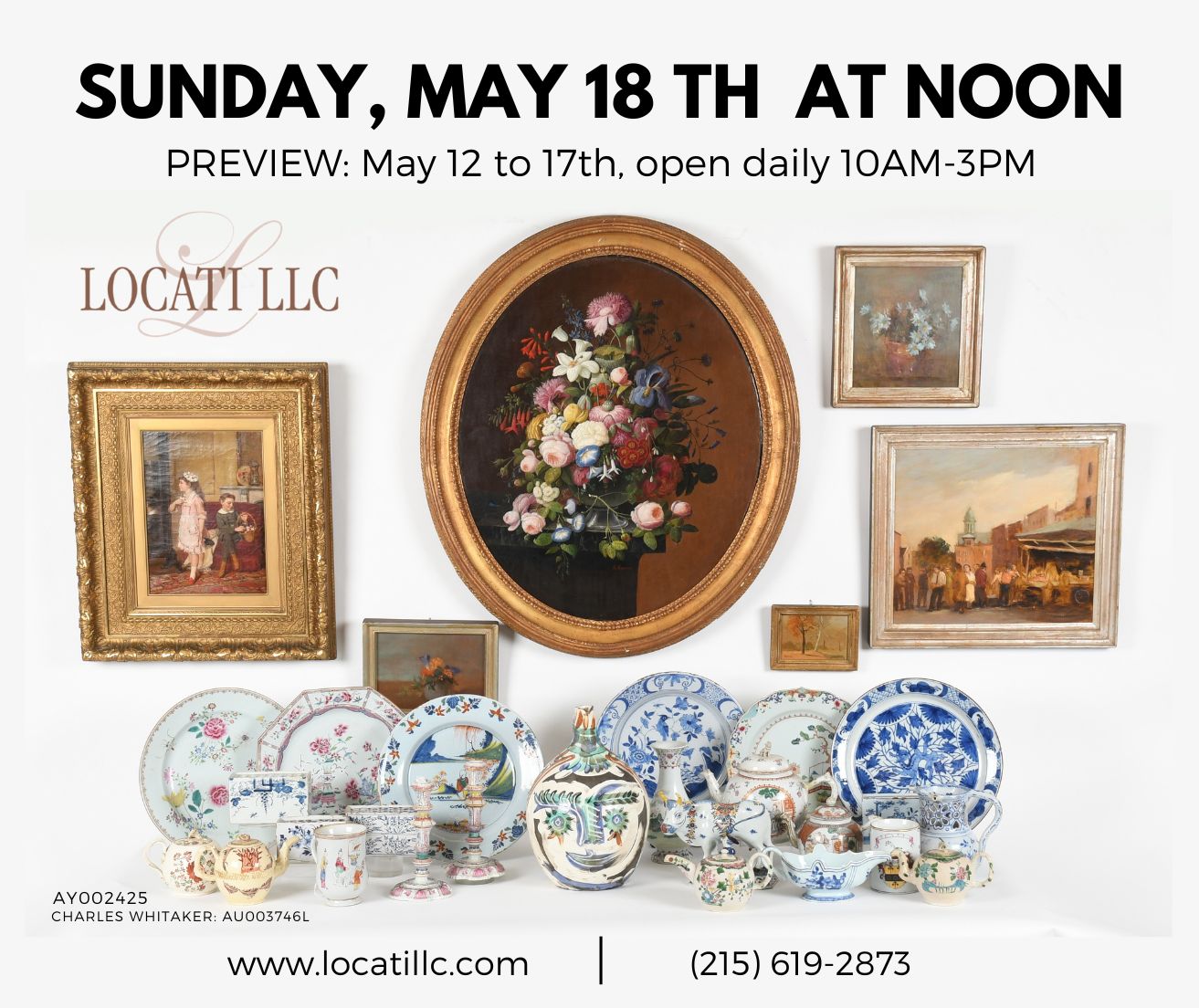The Ralph Esmerian Sale
January 25th, 2014
|
This 11½" x 9" needlework sampler has been given the title from the worked words “Adam and Eve in Paradice” [sic] and was made by Lydia Hart in Boston in 1744. The stitched inscription reads, “Adam and Eve in Paradice That Was The/ir Pedigree They Had A Grant Never To/ Die Would They Obedient Be. 1744.” It sold for $233,000 (est. $30,000/40,000) to David Schorsch and Eileen Smiles, underbid by dealers Stephen and Carol Huber. It had sold at Skinner on October 29, 1983, for $40,700. (The Hubers also had underbid it at that Skinner sale.) It is among Boston’s earliest group of samplers, which date 1725-54. Nine similar pieces show Adam and Eve with beasts, birds, and bugs. This one is the earliest with a border.
This polychrome paint-decorated pine miniature (8½" x 19 1/8" x 10") checkerboard chest, circa 1800, sold to a Pennsylvania collector in the salesroom for $377,000 (est. $50,000/75,000), underbid by David Wheatcroft and by David Schorsch and Eileen Smiles, bidding by phone through Nancy Druckman.
These watercolor, gouache, ink, and pencil on paper portraits by Jacob Maentel (1778-?) are of John Bickel and Caterina Bickel of Jonestown, Lebanon County, Pennsylvania, 1815-25. Each is 19" x 12". They sold for $401,000 (est. $200,000/300,000) to dealers David Schorsch and Eileen Smiles of Woodbury, Connecticut, for a client. The Maentel record is $687,500, paid for watercolor portraits of Mr. and Mrs. Samuel Ensminger and their baby at the Pook & Pook sale of the Koch collection in 1999.
Henry Walton (1804-1865) painted this 19¼" x 16" (sight) oil on canvas portrait of three children in a landscape circa 1838 in the Finger Lakes region of New York. It sold for $245,000 (est. $80,000/120,000), a record for the artist, to David Schorsch and Eileen Smiles. It is more academic and elegant than other folk portraits in the sale.
Wilhelm Schimmel (1817-1890) carved and painted the 7 3/8" x 7½" x 3" lion between 1860 and 1890 in Cumberland County, Pennsylvania. The carved pine figure sold to a Pennsylvania collector in the salesroom for $341,000 (est. $80,000/120,000). At Sotheby Parke Bernet’s sale of the Helen Janssen Wetzel collection on September 30, 1980, it had sold for $44,000, then a record for a Schimmel carving.
Attributed to Conrad Mumbouer (1761-1845) or John Monday (1809-1862) of Haycock Township, Bucks County, Pennsylvania, 1835-45, this 14 7/8" wide sgraffito-glazed red earthenware dish with flowers and heart is an exceedingly rare form. It sold to dealer David Wheatcroft for $281,000 (est. $40,000/60,000).
Attributed to John Drissel (active 1790-1835) of Milford Township, Bucks County, Pennsylvania, this painted pine hanging cupboard with spoon shelf was inscribed on the door front “Abraham Stauffer/ 1800.” The 19" x 10" x 5 3/8" cupboard sold for $209,000 (est. $80,000/120,000) to a Pennsylvania collector in the salesroom.
This 19½" x 14½" framed watercolor religious text with medallion above heart by Samuel Gottschall (1808-1898) of Salford Township, Montgomery County, Pennsylvania, is dated 1834. Done in ink, watercolor, and gouache on paper, it is inscribed around the center medallion in German. A translation was provided in the catalog: “Throughout your life have God before your eyes and in your heart and guard yourself that you do not sin willingly 1834,” and in the heart “Oh, finally/ finally the end comes/ of struggle, of woe/ and misery/ Then one sinks/ eternally into God’s arms/ This is the pious person’s/ last lot/ Written in the year 1834.” It sold for $106,250 (est. $15,000/20,000) to Pat Bell, partner in Olde Hope Antiques, New Hope, Pennsylvania.
This portrait titled Hatter John Mays of Schaefferstown by Jacob Maentel (1778-?) in watercolor, gouache, ink, and pencil on paper, 15½" x 12½", sold for $245,000 (est. $60,000/80,000). At Pook & Pook in Downingtown, Pennsylvania, on May 12, 2006, it had sold for $469,000. |
Sotheby’s, New York City
Photos courtesy Sotheby’s
Ralph Esmerian spent 30 years seeking the best American folk art. As the driving force and chairman of the board of trustees of the American Folk Art Museum, he promised his collection to the museum. In 2001, on the occasion of moving into its new building on East 53rd Street in Manhattan, the museum published American Radiance: The Ralph Esmerian Gift to the American Folk Art Museum,a large catalog of the collection with entries written by scholars in the field, and installed the collection. There were rave reviews.
Ten years later Esmerian, a leading dealer in colored gemstones, had overextended his business to include jewelry stores and pledged his collections as collateral to multiple creditors. He was sentenced to six years in federal prison for fraud for concealing assets from the bankruptcy court and for wire fraud.
The U.S. Bankruptcy Court ruled that the Esmerian collection had to be sold to satisfy creditors. The Museum of American Folk Art was allowed to choose 53 items to keep for the museum (valued at $7.8 to $11 million), and 228 items were ordered to be sold to satisfy creditors. Sotheby’s and Christie’s were among the creditors; Sotheby’s was selected as the venue.
The auction was held on Saturday morning, January 25, during Americana Week, when collectors are in New York City for sales and shows. The salesroom was packed. There were reserved seats for 400 bidders and market watchers, most of them clutching catalogs titled Visual Grace: Important American Folk Art from the Collection of Ralph O. Esmerian. It took four hours to sell it all, with bidders on the phone, on the Internet, and in the salesroom all competing.
It was a bittersweet sale. Just as the stunning preview exhibition opened at Sotheby’s, the Museum of Modern Art, which acquired the American Folk Art Museum building when the board of trustees could not meet its loan payment, announced it will certainly demolish it to make room for MoMA expansion.
Billionaires, multimillionaires, and dealers representing them signed up for paddles, which they waved in the air, competing with absentee bidders for the works they never thought they would have a chance to own. They spent $12,955,943 (including buyers’ premiums), well over the presale estimates (figured without the buyers’ premiums). The hammer total of about $10.5 million was well over the $7 million privately offered for the whole collection before the sale. The $7 million offer was said to be from dealers David Schorsch and Eileen Smiles of Woodbury, Connecticut, but Schorsch and Smiles would neither confirm nor deny that offer.
Schorsch bid from a skybox by phone to Nancy Druckman, Sotheby’s head of folk art. He said he was representing 11 clients and purchased 37 lots for six of them. He spent almost $4 million, about $1 million of it for stock.
Schorsch said that 32 items in the sale had been bought by Esmerian from his mother, Marjorie Schorsch (1930-2007), or from him in the years 1978 to 1995 for a total of $946,000 and that they sold for a total of $3,258,813, a tidy profit of $2.3 million. “Esmerian reached for the best, and the best holds value and increases over time,” said Schorsch in an interview after the sale.
Sotheby’s reported the sale as a record total for any sale of American folk art, topping the $12,299,528 for the two-part Bertram K. and Nina Fletcher Little sale of 1072 lots held in four sessions in January and October 1994, when the buyer’s premium was 15% on any amount up to $50,000 and 10% on the rest. (The hammer total for that Little sale was higher at $10.9 million.) The Littles’ collection was put together by scholarly antiquarians; Esmerian bought the art in folk art. It was a record for any single-session single-catalog folk art sale.
Some staggering prices were paid, and there were some good buys. It was an erratic sale, and not every lot sold. Of the 228 lots offered, 188 found buyers, which is 82.5% sold by lot. According to Sotheby’s, the sale was 93.7% sold by value, which shows that a few lots with too high estimates failed to sell. According to Bloomberg News, liquidation trustee Jay Teitelbaum said, “Even with this very good result, creditors still will be looking at recovery of less than ten cents on the dollar.” Teitelbaum must figure out how to best sell the 40 bought-in lots, valued at around $990,000.
There were plenty of record prices. The figure of Santa Claus that New York carver Samuel Robb carved for his daughter Elizabeth in 1923 sold for $875,000 (includes buyer’s premium), well over its estimate and a record for carving by a carver of trade figures. The buyers, David Schorsch and Eileen Smiles, said they did not buy it for Jane Katcher, their major client, who watched the sale with them from the skybox. The underbidder was dealer Leigh Keno, bidding for his clients Marjorie and John McGraw, who were sitting with him.
There was keen competition for the portrait of Jeremiah H. Emerson by Ruth Whittier Shute and Samuel
Addison Shute. It went to a Pennsylvania collector in the salesroom for an auction record for the artists at $665,000 (est. $150,000/200,000), underbid by dealer David Wheatcroft of Westborough, Massachusetts, a major buyer at the sale.
On behalf of a client, dealer Peter Sawyer of Exeter, New Hampshire, paid $521,000 (est. $100,000/150,000) for the three watercolor and pencil portraits of the Carver family (Barnabas Bartol Carver, Mary Coffin Carver, and their small daughter Frances Ann Carver) painted in Freeport, Maine, circa 1835. Wheatcroft was the underbidder.
On behalf of collectors, dealer Deanne Levison of Atlanta outbid Schorsch and Smiles to buy a carved pine pheasant hen weathervane for $449,000 (est. $200,000/300,000).
The work of Jacob Maentel, an itinerant painter who recorded the prosperous farmers and tradesmen in Pennsylvania and Indiana using watercolor and gouache on paper, was enthusiastically embraced. Maentel’s portraits of John Bickel and Caterina Bickel in their parlor decorated with bright blue wallpaper sold for $401,000 (est. $200,000/300,000) to Schorsch and Smiles, underbid by David Wheatcroft. Maentel’s portrait of the hatter John Mays of Schaefferstown went to David Wheatcroft for a client and seemed like a bargain at $245,000 (est. $60,000/80,000). Wheatcroft had bought it for Ralph Esmerian at a sale at Pook & Pook in May 2006 for $469,000. David Schorsch was the underbidder at both sales.
Less colorful but charming Maentel portraits of Elizabeth Haak and Michael Haak sold for $233,000 (est. $80,000/120,000) to collectors on the phone. The same collectors paid $389,000 for a pair of portraits, possibly of Captain and Mrs. Fitzhugh Greene, attributed to John Durand, 1768-70, paying less than their aggressive estimates of $400,000/600,000.
Schorsch and Smiles bought the Shutes’ portrait of Mary Ann Russell for $317,000 (est. $30,000/50,000), underbid by David Wheatcroft. Wheatcroft and Schorsch were both bidding on a box painted with a polychrome checkerboard, made in Somerset County, Pennsylvania, and misattributed in the catalog to Schoharie County, New York; both think they were the underbidder. It sold to a Pennsylvania collector in the salesroom for $377,000 (est. $50,000/75,000). The same buyer paid a record $341,000 (est. $80,000/120,000) for the Wilhelm Schimmel carved and painted pine lion that had sold at Sotheby’s Wetzel sale near Reading in 1980 for the then-record $44,000.
New York City collector Jerry Lauren, who buys the best of the works by Bill Traylor, paid a record $365,000 (est. $125,000/175,000) for Bill Traylor’s blue and black Man with a Plow, for which Ralph Esmerian had paid a record $178,500 at the first sale of Traylor drawings at Sotheby’s in December 1997.
What will be the impact on the market of these big prices paid by a handful of wealthy collectors as passionate about folk art as Ralph Esmerian and who are willing to pay what it takes to own it?
“It should give the market a lift,” said David Wheatcroft, adding, “The updraft will only last if the economy improves.”
Will the fact that so many lots whizzed by high estimates restore some confidence in the market? David Schorsch said the impact had already been felt at the New York Winter Antiques Show, where sales were brisk on Sunday, Monday, and Tuesday after the sale. “It has ushered in a new era,” he said.
Many wonder if ever again another collection of this quality will come to a salesroom. Great works are out there, but some of them will go to museums. Druckman, who often had bid for Ralph Esmerian, said she was happy to see people so excited about the objects and anxious to share their enthusiasm. “It was a great gathering of the clan,” she said. “It was the sale that defines this field of American folk art.”
It was without a doubt a landmark sale. The pictures and captions tell more of the story. There are no images of redware figures or animals; half a dozen did not sell because of high estimates for works with repairs. The Mahantongo desk was found to have surface problems and failed to get a bid. Records include a painted Mahantongo spice cup for $245,000 (est. $80,000/120,000) to dealers C.L. Prickett of Yardley, Pennsylvania; a Shaker rug for $161,000 (est. $8000/12,000) to Schorsch and Smiles; a painted yarn reel, $31,250 (est. $6000/8000) to a phone bidder (it had brought a record $16,500 at Sotheby’s in January 1987); and $28,125 (est. $8000/12,000) for a sugar bucket signed by Joseph Lehn. Lehn sugar buckets sell regularly at auctions in Pennsylvania for $3000 to $5000. This one was in fine condition and had a paper label with “Joseph Lehn in his 91 year, Dec 16, 1888”—an example of the best and the rest.
The Santa carved by Robb ($875,000) was a record for a trade figure; the portrait of Jeremiah Emerson ($665,000), a record for a Shute watercolor. The triple portrait by the so-called Carver Limner ($521,000) was a record for the artist. The portrait of three children in a landscape by Henry Walton ($245,000) is a record for the artist. Man with a Plow made a record for a Bill Traylor, and the lion made a record for a carving by Wilhelm Schimmel. The box by George Robert Lawton (1813-1885) at $209,000 (est. $30,000/40,000) is a Lawton record. There may be other record prices.
Todd Prickett bought several lots of Pennsylvania redware, among them one slipware and two sgraffito plates and a slipware jar, knowing it will be hard to find better examples. Patrick Bell of Olde Hope Antiques bought multiple lots, including several frakturs. Wheatcroft, Sawyer, and Schorsch were major buyers along with a private collector in the salesroom and two private collectors bidding by phone.
The American Folk Art Museum bought three lots. One was a redware plate with a silhouette of a running horse for $34,375 (est. $30,000/40,000), for which Esmerian paid $8250 in February 1978. Another was a manuscript book with 40 decorated pages for $53,125 (est. $25,000/35,000). The third lot consisted of a miniature slipware plate together with a potter’s slip-trailing cup for $8750. The small slipware plate was the first piece of American folk art that Ralph Esmerian bought for himself in 1966, when he went to buy a coverlet as a gift for his friend June Ewing. In American Radiance he wrote in the introduction about how he slipped the small plate into his pocket as he left John Gordon’s gallery with the bulky birthday present in his arms. Esmerian had bought the unidentified potter’s slip-trailing cup in May 1995 at Sotheby’s sale of the Deyerle collection for $1610.
Some wondered if Ralph Esmerian was able to watch the sale on a computer from U.S. Penitentiary Canaan in Waymart, Pennsylvania. Bloomberg News reports that he is scheduled to be released on November 29, 2016, according to the Web site of the U.S. Bureau of Prisons.
For more information about the sale, contact Sotheby’s at (212) 606-7000 or (www.sothebys.com).
|
|
|
|
|
|
|
|
|
|
|
|
|
|
|
|
|
|
|
|
Originally published in the March 2014 issue of Maine Antique Digest. © 2014 Maine Antique Digest
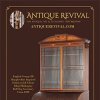






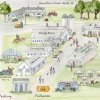

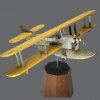










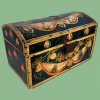
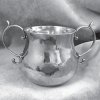
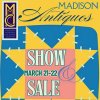





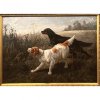


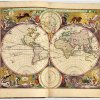
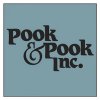
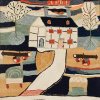
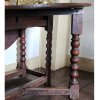
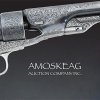

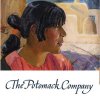

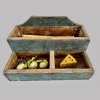

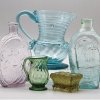








 This 35½" x 11½" x 13¼" carved and painted pine newsboy, eastern or midwestern United States, circa 1880, is inscribed on the front of base “Ossendorf Brand 90” and on the newspaper front “Tobacco & Cigars.” The carving sold to Pat Bell, partner in Olde Hope Antiques, New Hope, Pennsylvania, for $209,000 (est. $60,000/80,000). It has a Gerald Kornblau provenance.
This 35½" x 11½" x 13¼" carved and painted pine newsboy, eastern or midwestern United States, circa 1880, is inscribed on the front of base “Ossendorf Brand 90” and on the newspaper front “Tobacco & Cigars.” The carving sold to Pat Bell, partner in Olde Hope Antiques, New Hope, Pennsylvania, for $209,000 (est. $60,000/80,000). It has a Gerald Kornblau provenance.
 This painted poplar spice cup is attributed to Jared Stiehly (1833-1911) and Elizabeth Mayer Stiehly (1826-1878), Mahantongo or Schwaben Creek Valley, Northumberland and Schuylkill Counties, Pennsylvania. It’s inscribed on lid “Isaac Stiely [sic], May 1861.” Measuring 7¾" tall x 4" in diameter, it sold for $245,000 (est. $80,000/120,000) to dealer Todd Prickett in the salesroom. The Reverend Isaac Faust Stiehly (1800-1869) was a prominent itinerant minister serving a number of German Reformed churches in the Mahantongo Valley region of the adjoining Northumberland and Schuylkill Counties of Pennsylvania. A man of multiple talents, he was also a stonecutter, millwright, and farmer. This ornately turned and decorated covered spice cup is thought to have been made by Isaac’s son Jared and decorated by Jared’s wife, Elizabeth Mayer Stiehly, as a presentation gift, probably on the occasion of the minister’s 60th birthday. A closely related covered cup by these artists was sold at Sotheby’s in 1997 for $11,500. Olde Hope Antiques sold one at the Philadelphia Antiques Show, last April for around $80,000.
This painted poplar spice cup is attributed to Jared Stiehly (1833-1911) and Elizabeth Mayer Stiehly (1826-1878), Mahantongo or Schwaben Creek Valley, Northumberland and Schuylkill Counties, Pennsylvania. It’s inscribed on lid “Isaac Stiely [sic], May 1861.” Measuring 7¾" tall x 4" in diameter, it sold for $245,000 (est. $80,000/120,000) to dealer Todd Prickett in the salesroom. The Reverend Isaac Faust Stiehly (1800-1869) was a prominent itinerant minister serving a number of German Reformed churches in the Mahantongo Valley region of the adjoining Northumberland and Schuylkill Counties of Pennsylvania. A man of multiple talents, he was also a stonecutter, millwright, and farmer. This ornately turned and decorated covered spice cup is thought to have been made by Isaac’s son Jared and decorated by Jared’s wife, Elizabeth Mayer Stiehly, as a presentation gift, probably on the occasion of the minister’s 60th birthday. A closely related covered cup by these artists was sold at Sotheby’s in 1997 for $11,500. Olde Hope Antiques sold one at the Philadelphia Antiques Show, last April for around $80,000. Painted by the so-called Carver Limner are these portraits framed together of Barnabas Bartol Carver, Mary Coffin Carver, and Frances Ann Carver, with paper note on back reading “Mr. Carver: Barnabas Bartol Carver/ Born in Freeport Maine/5/26-1799-D—[?]; Mrs. Carver: Mary Coffin Carver /B 1801-D. Freeport d.1873/ Married Barnabas Carver/ B. 1799-Freeport 1873/ Parents of Frances Ann Carver; Daughter of/ Barnabas B. and Mary C. …Carver/ Frances Ann—B 1832—D. 1920.” Each watercolor and pencil on paper is 22" x 18" and was painted circa 1835 in Freeport, Cumberland County, Maine. They sold to dealer Peter Sawyer of Exeter, New Hampshire, for $521,000 (est. $100,000/150,000). It is a record for the artist.
Painted by the so-called Carver Limner are these portraits framed together of Barnabas Bartol Carver, Mary Coffin Carver, and Frances Ann Carver, with paper note on back reading “Mr. Carver: Barnabas Bartol Carver/ Born in Freeport Maine/5/26-1799-D—[?]; Mrs. Carver: Mary Coffin Carver /B 1801-D. Freeport d.1873/ Married Barnabas Carver/ B. 1799-Freeport 1873/ Parents of Frances Ann Carver; Daughter of/ Barnabas B. and Mary C. …Carver/ Frances Ann—B 1832—D. 1920.” Each watercolor and pencil on paper is 22" x 18" and was painted circa 1835 in Freeport, Cumberland County, Maine. They sold to dealer Peter Sawyer of Exeter, New Hampshire, for $521,000 (est. $100,000/150,000). It is a record for the artist. Jacob Maentel (1778-?) made this portrait of Young Mr. Faul, watercolor, gouache, ink, and pencil on paper, 15 7/8" x 10 7/8", 1835-38, in Lancaster County, Pennsylvania. It sold for $161,000 (est. $30,000/50,000) to Patrick Bell of Olde Hope Antiques, New Hope, Pennsylvania. At the Edgar William and Bernice Chrysler Garbisch sale in April 1977, it had sold for $13,000.
Jacob Maentel (1778-?) made this portrait of Young Mr. Faul, watercolor, gouache, ink, and pencil on paper, 15 7/8" x 10 7/8", 1835-38, in Lancaster County, Pennsylvania. It sold for $161,000 (est. $30,000/50,000) to Patrick Bell of Olde Hope Antiques, New Hope, Pennsylvania. At the Edgar William and Bernice Chrysler Garbisch sale in April 1977, it had sold for $13,000. Ruth Whittier Shute (1803-1882) and Samuel Addison Shute (1803-1836) worked together as artists. This portrait of Jeremiah H. Emerson is inscribed on the book in the painting “The Progressive Reader/ Jeremiah H/ Emerson/ Nashua, NH.” The 29¼" x 19" watercolor, gouache, pencil, and ink on paper with applied gold foil was painted in Nashua, Hillsborough County, New Hampshire, circa 1832. It sold to a Pennsylvania collector in the salesroom for $665,000 (est. $150,000/200,000). At Sotheby Parke Bernet in June 1979, it had sold for $25,300.
Ruth Whittier Shute (1803-1882) and Samuel Addison Shute (1803-1836) worked together as artists. This portrait of Jeremiah H. Emerson is inscribed on the book in the painting “The Progressive Reader/ Jeremiah H/ Emerson/ Nashua, NH.” The 29¼" x 19" watercolor, gouache, pencil, and ink on paper with applied gold foil was painted in Nashua, Hillsborough County, New Hampshire, circa 1832. It sold to a Pennsylvania collector in the salesroom for $665,000 (est. $150,000/200,000). At Sotheby Parke Bernet in June 1979, it had sold for $25,300. Samuel Anderson Robb (1851-1928) of New York carved and painted wooden trade figures. His 38¾" x 16" x 15 7/8" Santa Claus is inscribed on the underside of the base: “This Is The/ Last Figure/ Made By Samuel A. Robb/ About 1923/ Elizabeth W. Robb/ May 16, 1966.” It sold for $875,000 (est. $150,000/250,000) to David Schorsch and Eileen Smiles for a client. At Sotheby Parke Bernet in October 1983, it had sold for a jolly $44,000. Robb created this characterization of Santa Claus as a Christmas present for his daughter Elizabeth in 1923. According to her, it was the last figure that Robb carved. The catalog notes, “Robb closed his workshop at 114 Centre Street in 1903, not long after completing a series of elaborate carvings for circus wagons for Barnum & Bailey. For the next few years, he kept small shops in various locations in Manhattan and, from 1908 to 1910, shared space in Brooklyn with another carver, Charles Brown. After that, he worked out of his home, first on 156th Street and then on Seaman Avenue in upper Manhattan, where this figure was made.”
Samuel Anderson Robb (1851-1928) of New York carved and painted wooden trade figures. His 38¾" x 16" x 15 7/8" Santa Claus is inscribed on the underside of the base: “This Is The/ Last Figure/ Made By Samuel A. Robb/ About 1923/ Elizabeth W. Robb/ May 16, 1966.” It sold for $875,000 (est. $150,000/250,000) to David Schorsch and Eileen Smiles for a client. At Sotheby Parke Bernet in October 1983, it had sold for a jolly $44,000. Robb created this characterization of Santa Claus as a Christmas present for his daughter Elizabeth in 1923. According to her, it was the last figure that Robb carved. The catalog notes, “Robb closed his workshop at 114 Centre Street in 1903, not long after completing a series of elaborate carvings for circus wagons for Barnum & Bailey. For the next few years, he kept small shops in various locations in Manhattan and, from 1908 to 1910, shared space in Brooklyn with another carver, Charles Brown. After that, he worked out of his home, first on 156th Street and then on Seaman Avenue in upper Manhattan, where this figure was made.” This knitted wool rug, attributed to Elvira Curtis Hulett (circa 1805-1895), probably Hancock, Berkshire County, Massachusetts, 1890-95, is 50" in diameter and sold for a record $161,000 (est. $8000/12,000) to David Schorsch, underbid on the phone. David Wheatcroft said he sold a similar rug before the crash for $35,000.
This knitted wool rug, attributed to Elvira Curtis Hulett (circa 1805-1895), probably Hancock, Berkshire County, Massachusetts, 1890-95, is 50" in diameter and sold for a record $161,000 (est. $8000/12,000) to David Schorsch, underbid on the phone. David Wheatcroft said he sold a similar rug before the crash for $35,000. This circa 1845 2¼" x 7½" painted pine and maple round box with heart decorations by George Robert Lawton (1813-1885) of North Scituate, Providence County, Rhode Island, sold to David Schorsch and Eileen Smiles for $209,000 (est. $30,000/40,000). At Skinner in 1983, it had sold for $9075 with two birds inside. The birds (offered as another lot 18 lots later) cost Schorsch and Smiles $5938.
This circa 1845 2¼" x 7½" painted pine and maple round box with heart decorations by George Robert Lawton (1813-1885) of North Scituate, Providence County, Rhode Island, sold to David Schorsch and Eileen Smiles for $209,000 (est. $30,000/40,000). At Skinner in 1983, it had sold for $9075 with two birds inside. The birds (offered as another lot 18 lots later) cost Schorsch and Smiles $5938. By an unidentified artist, this 7 7/8" x 12¾" watercolor on paper taufschein for Catharina Eberhard, southeastern Pennsylvania, circa 1780, sold for $149,000 (est. $20,000/30,000) to dealers David Schorsch and Eileen Smiles of Woodbury, Connecticut, underbid by collectors in the room. It was the highest price paid for a fraktur in the sale.
By an unidentified artist, this 7 7/8" x 12¾" watercolor on paper taufschein for Catharina Eberhard, southeastern Pennsylvania, circa 1780, sold for $149,000 (est. $20,000/30,000) to dealers David Schorsch and Eileen Smiles of Woodbury, Connecticut, underbid by collectors in the room. It was the highest price paid for a fraktur in the sale.  Collector Jerry Lauren of New York City bought Man with a Plow by Bill Traylor (1852/56-1949) for $365,000 (est. $125,000/175,000). The 15" x 25¾" poster paint and pencil on paperboard was painted in Montgomery, Alabama. At Sotheby’s on December 3, 1997, it had sold for $178,500.
Collector Jerry Lauren of New York City bought Man with a Plow by Bill Traylor (1852/56-1949) for $365,000 (est. $125,000/175,000). The 15" x 25¾" poster paint and pencil on paperboard was painted in Montgomery, Alabama. At Sotheby’s on December 3, 1997, it had sold for $178,500. This rare Shaker watercolor gift drawing, titled from part of its inscription “1st My Children Dear, Whom I Do Love” by Polly Collins (1801-1884) of Hancock, Berkshire County, Massachusetts, is dated 1854. The 19" x 12" ink, pencil, and watercolor on paper sold for $125,000 (est. $125,000/175,000) to David Schorsch and Eileen Smiles for inventory. David Schorsch said it is the only colored Shaker spirit drawing in private hands. They also bought four Shaker gift drawings (framed together) for $221,000 (est. $30,000/50,000).
This rare Shaker watercolor gift drawing, titled from part of its inscription “1st My Children Dear, Whom I Do Love” by Polly Collins (1801-1884) of Hancock, Berkshire County, Massachusetts, is dated 1854. The 19" x 12" ink, pencil, and watercolor on paper sold for $125,000 (est. $125,000/175,000) to David Schorsch and Eileen Smiles for inventory. David Schorsch said it is the only colored Shaker spirit drawing in private hands. They also bought four Shaker gift drawings (framed together) for $221,000 (est. $30,000/50,000).
